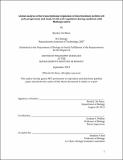Global analysis of the transcriptional regulation of Sinorhizobium meliloti cell cycle progression and study of cell cycle regulation during symbiosis with Medicago sativa
Author(s)
De Nisco, Nicole J.
DownloadFull printable version (5.874Mb)
Other Contributors
Massachusetts Institute of Technology. Department of Biology.
Advisor
Graham C. Walker.
Terms of use
Metadata
Show full item recordAbstract
The complex [alpha]-proteobacterial cell cycle regulatory network is essential not only for faithful replication and segregation of the genome, but also to coordinate unique cellular differentiation events that have evolved as adaptations to the different lifestyles of this diverse group of bacteria. The soil-dwelling [alpha]-proteobacterium, Sinorhizobium meliloti, not only has to accurately coordinate the replication of its tripartite genome, but also must undergo a dramatic cellular differentiation in order to form an effective symbiosis with the legume Medicago sativa. Preliminary analyses have indicated that plasticity in the S. meliloti cell cycle regulatory network may be essential to symbiosis, but cell cycle research in S. meliloti has been hindered largely by lack of a method to obtain synchronous populations of S. meliloti. In this thesis, I present the first method to generate synchronous cultures of S. meliloti. I performed microarray gene expression analysis on synchronous populations of S. meliloti to gain a global view of transcriptional regulation of cell cycle events. This represents the first work of this kind done in an [alpha]-proteobacterium besides Caulobacter crescentus, which is the current model for [alpha]-proteobacterial cell cycle studies. The importance of transcriptional regulation of cell cycle progression was first discovered in C. crescentus and the work presented in this thesis highlights the conservation of cell cycle regulated gene expression in S. meliloti. I identified 462 cell cycle regulated transcripts in S. meliloti, which included genes involved in vital cell processes such as cell division, flagella biogenesis, replication and segregation of its tripartite genome as well as several putative cell cycle regulators. I compared the set of genes with cell cycle regulated transcripts identified in my analysis with the set identified in C. crescentus to generate a core set of 128 conserved genes demonstrating cell cycle regulated gene expression in both species. To determine which of the S. meliloti genes with cell cycle regulated transcripts might be part of the CtrA and DnaA regulons in S. meiloti, I performed CtrA and DnaA binding motif analysis. To understand the evolutionary significance of these CtrA and DnaA binding motifs, I looked at conservation of these motifs in homologous genes from several related [alpha]-proteobacteria. The results indicated that the putative CtrA regulon might be more evolutionarily constrained than the putative DnaA regulon. Organisms more closely related to S. meliloti or with more similar lifestyles demonstrated a much greater conservation of the CtrA binding motifs identified in S. meliloti. The CtrA binding motifs in S. meliloti identified by my analysis were not at all well conserved in C. crescentus, which was the most distantly related [alpha]-proteobacteria surveyed. These differences in cell cycle regulated transcription and the putative CtrA regulon between S. meliloti and C. crescentus thus appear to represent specific adaptations to the distinctive genome and unique intracellular symbiotic lifestyle of S. meliloti and illustrate the importance of S. meliloti as a model for cell cycle regulation in [alpha]-proteobacteria with similar intracellular lifestyles. The work presented in this thesis also describes the importance of CtrA regulation in S. meliloti during symbiosis with M. sativa. A crucial part of this symbiosis is a striking cellular differentiation (termed bacteroid differentiation), which includes changes in membrane permeability, cell elongation and branching, endoreduplication of the genome and loss of reproductive capacity and therefore a significant deviation from the free-living cell cycle program. Endoreduplication of the genome requires a decoupling of DNA replication and cell division, which could be achieved by down-regulation of the essential master cell cycle regulator CtrA. I tested the effects of CtrA depletion in S. meliloti and found that CtrA depletion induces a bacteroid-like state characterized by elongated and branched cells and highly elevated DNA content. I also show that S. meliloti CtrA has a comparable half-life to C. crescentus CtrA, but regulated proteolysis of CtrA may be different in the two species since we found CtrA proteolysis to be essential in S. meliloti. In addition, I demonstrate that the promoter and coding regions of C. crescentus ctrA cannot complement an S. meliloti ctrA chromosomal deletion during symbiosis even though they can do so in the free-living state. My attempts to identify the defects in the function C. cresentus ctrA promoter or coding region within M. sativa gave surprising results since S. melioti strains expressing C. crescentus CtrA from the S. meliloti ctrA promoter region and vice versa were able to establish an effective symbiosis with M. sativa. I discuss several possibilities to explain this apparent paradox, but further study is required to fully clarify this observation. Taken as a whole, my thesis work represents a significant advancement to the field of cell cycle research in S. meliloti and [alpha]-proteobacteria as a whole. The cell synchronization method I developed will greatly facilitate more comprehensive analysis of cell cycle regulation in S. meliloti. My microarray gene expression analysis provides a global view of cell cycle regulated transcription in S. meliloti, which can be used in more in-depth explorations of specific mechanisms of transcriptional regulation of cell cycle events in S. meliloti. Lastly, my study of CtrA function in S. meliloti establishes the importance of CtrA regulation during symbiosis with M. sativa.
Description
Thesis (Ph. D.)--Massachusetts Institute of Technology, Dept. of Biology, 2013. This electronic version was submitted by the student author. The certified thesis is available in the Institute Archives and Special Collections. Cataloged from student-submitted PDF version of thesis. Includes bibliographical references.
Date issued
2013Department
Massachusetts Institute of Technology. Department of BiologyPublisher
Massachusetts Institute of Technology
Keywords
Biology.